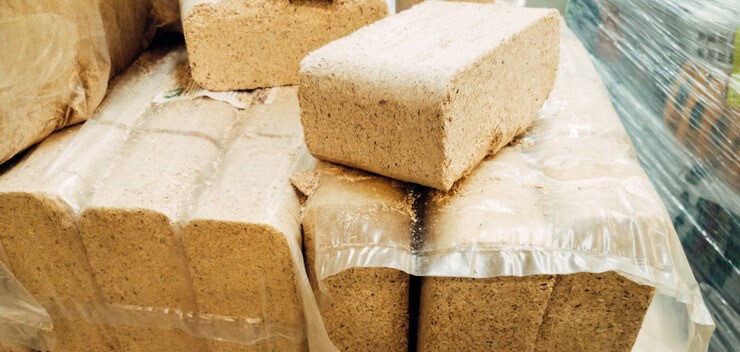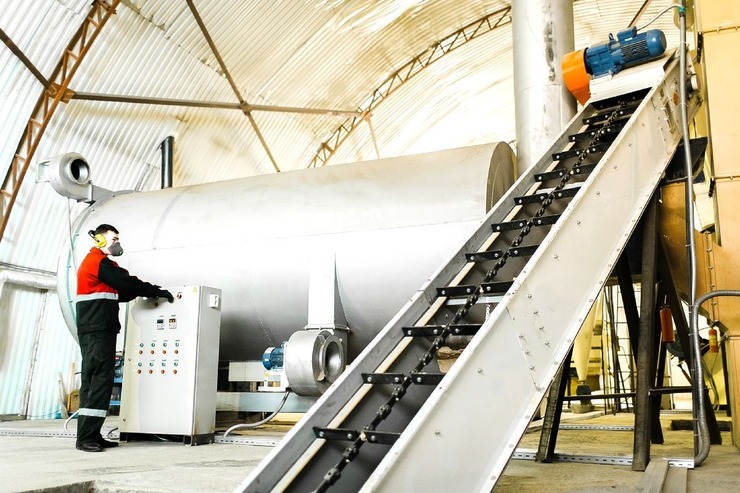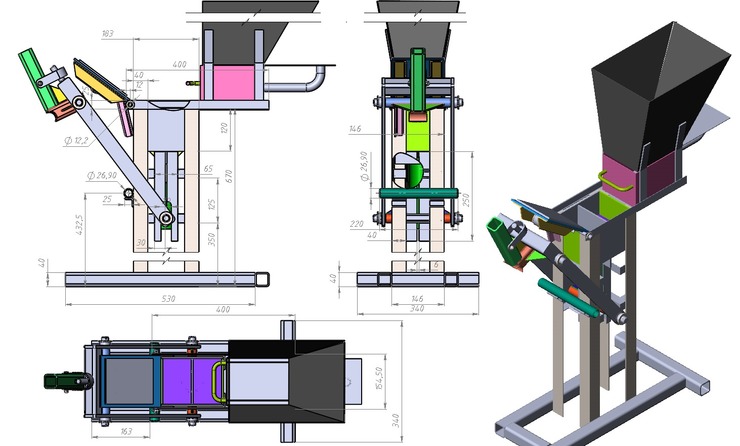The subtleties of making a press for fuel briquettes with your own hands
Recently, energy resources are considered to be of great value, so people are trying to find alternative energy sources everywhere.
Recycled sawdust, leaves or other waste from the agricultural industry can be an excellent fuel. But in order to turn them from garbage into a useful material, it is necessary to use a special installation - a briquette press.
Recycled sawdust has recently become more and more popular as an alternative energy source.
general information
The press for the production of briquettes consists of several units and mechanisms.
These include the following parts:
- The table (base) to which the rest of the nodes are attached, including the matrix that forms the future fuel.
- Power frame fixed on the base. Its task is to transfer force through the punch to the material.
- Mechanical or manual drive. In the first case, a hydraulic booster or an electric motor is considered, and in the second, muscular strength or an additional jack.
Before you start using the press, you need to understand the principle of its operation and areas of application.
The advantages of the power structure are obvious:
- It allows you to create inexpensive raw materials with good energy value and high density.
- With its help, you can provide yourself with affordable fuel for space heating throughout the cold season. For owners of homes located away from gas mains, or people who want to save money on heating, this decision is fully justified.

It looks like pressed wood into briquettes industrially
Pros and cons
The main advantage of such installations is the low cost of the briquette, which is used as fuel. With the help of such products, you can heat a woodworking shop or equip independent heating of a greenhouse. Recycled vegetable waste is capable of producing an impressive amount of thermal energy, making it a worthy competitor for many types of fuel. As a result, the manufacture of presses is becoming more and more relevant and in demand.
Another plus of the fuel created on such equipment is the low percentage of ash content. As a result of the combustion of briquettes, organic ash appears without harmful impurities and additives, so it is often used as a fertilizer for the soil.
 Automatic system with vertical design for the production of fuel briquettes is a compact automatic unit of continuous operation
Automatic system with vertical design for the production of fuel briquettes is a compact automatic unit of continuous operation The disadvantages include high hygroscopicity of the final product, so it has to be stored in special conditions, where there is no any humidity. In terms of strength, compressed waste is inferior to the rest of the solid fuel, which leads to the formation of dust during the operation of briquettes. Often, this dust causes an allergic reaction in consumers, and if it accumulates in large volumes, this leads to the creation of an explosive and flammable mixture.
Among the key varieties of industrial equipment are:
- automatic systems;
- semi-automatic installations;
- models for small-scale production.
Installations can be hydraulic, pneumatic or screw. There are also models with vertical or horizontal execution.
How to make a press for fuel briquettes with your own hands:
Briquette production technology
Understand, how to make your own briquette press, is relatively simple. To do this, you need to follow the general recommendations and follow the step-by-step guide.
The task of such a mechanism is to grind the feedstock, which is usually used as the waste of woodworking enterprises, as well as its further drying. To make fuel from wood waste, its moisture content must be increased to 8-10%. In addition to plant components, coal dust is also involved in the production of briquettes.
After preparing the necessary components, you can proceed directly to the manufacture of the briquette using one of two technologies:
- Pressing. In this case, the feedstock must be placed in a special form called a matrix and crushed using a powerful hydraulic press. The part that acts on the raw material is called the punch. The machine itself is capable of developing pressure up to 300-600 atmospheres.
- Extrusion. According to the principle of operation, a professional extruder resembles a screw meat grinder. The feedstock passes through a narrowing channel, and the pressure that acts on it is about 1000 atmospheres.
 Technology for the production of briquettes on an industrial scale by pressing
Technology for the production of briquettes on an industrial scale by pressing With strong compression, the prepared mass is heated to high temperatures. Sticky substances are released from small particles of material, which begin to bind the mass and make it solid. Raw material density indicators reach 900-1100 kg/1 m³. For comparison, for high-quality wood, they are 500-550 kg / 1 m³. The processed mass acquires a high thermal potential, and its energy value doubles.
Such briquettes burn several times longer than ordinary wood. As a result, they go through the stage of heat treatment, they are cut into equal parts and delivered to the warehouse.
Faced with the issue of producing fuel from waste, many have a dilemma between buying factory equipment and making a press for fuel briquettes with their own hands according to the drawings.
Advantages of homemade designs
The cost of an industrial press for the manufacture of briquettes ranges from 300 thousand to 1 million rubles. Few people are ready to lay out such an amount, so the independent manufacture of the machine is becoming more and more relevant. Yes, and it is not advisable to buy such an expensive mechanism for your own domestic needs, since its payback is very low.
As for homemade presses, it is quite possible to make them at home. In this case, you can try to build the system from scratch or purchase several nodes for assembly.
 According to the scheme, it is quite possible to make a home-made press machine at home
According to the scheme, it is quite possible to make a home-made press machine at home Considering the option of manufacturing from scratch, you need to acquire such mechanisms for compression:
- Lever.
- screw mechanism.
The first device is characterized by a simple design, while it can be made from ordinary wood. As for screw mechanisms, they imply the presence of steel billets and a lathe. A more complex screw extruder in terms of production is also created by hand, but for this purpose you have to buy expensive top-class steel.
Heating a room with briquettes from vegetable waste is not only cheap, but also environmentally friendly. This is explained by the absence of harmful additives and impurities in the composition of the fuel. To equip the heating system, you can use a home-made pellet boiler or slightly upgrade the finished solid fuel installation.
Manufacturing based on other devices
If there is no desire to create a press for making briquettes from scratch, then you can try to recycle some other device for such a mechanism. It can be a jack or a small hydraulic press, which is additionally equipped with a punch and a matrix.
At the same time, it is important to understand that all home-made installations are not capable of providing the pressure at which lignin is produced. As a result a number of third-party additives are added to the original mass, including:
- inexpensive adhesive (for example, for wallpaper);
- clay (10 parts of waste are taken for 1 part of the raw material);
- soaked paper or corrugated board.
Being engaged in the production of a machine for briquettes, it is important to take into account such a stage as grinding raw materials. Manual cutting of the material is not recommended, since such manipulation takes a lot of time and effort. Instead, it is recommended to use additional devices, for example, a grinder from an old activator washing machine, in which knives are placed. You can also buy a rotary machine. Its task is to grind plant components.
 The grinding of raw materials is also important, and manual cutting of the material is not recommended, since such manipulation takes a lot of time and effort.
The grinding of raw materials is also important, and manual cutting of the material is not recommended, since such manipulation takes a lot of time and effort. For the successful manufacture of a lever or screw press, you do not need to buy additional parts. However, such devices do not have special working properties. A press from a hydraulic jack, on which an electric or manual drive is installed, will be more effective.
A punch is added to the finished equipment, the dimensions of which are comparable to the dimensions of the matrix where the pressing takes place. To create a matrix, a thick-walled pipe is taken, in which holes are made for the ventilation system. The matrix is additionally equipped with a removable bottom - it can be removed after receiving the finished briquette.
Materials and improvised means
To make a briquette press with your own hands, you need to stock up on some materials and improvised means. In addition to the main component, you will also have to buy different types of rolled steel:
- channel;
- corner with dimensions 100x100 mm;
- sheet 3-6 mm thick, from which the punch will need to be cut. The thickness of the workpiece is determined by the diameter of the matrix.
It is also necessary to prepare a pipe with a cross section of 25-30 mm for the manufacture of the punch rod, a thick-walled pipe for the die and a larger one for the body. In the absence of such material, the drum can be created from a sheet of tin. Also, galvanized steel is being prepared for the upcoming work - trays are created from it.
The machine is assembled according to the following instructions:
- Equip the base of the device. It is created from channels using a welding machine.
- On the basis of the corner, four racks 1.5 m long are made. They are welded vertically with the same pitch.
- Further, a drum is created from a steel pipe or sheet of tin, where the mixing of the feedstock will be carried out. If there is a failed washing machine in the house, the drum can be removed from it.
- Then the drum structure is welded to the racks. If possible, it is better to equip it with an engine. If the power plant generates strong vibrations during operation, and its rotation speed is too high, this can be solved using a gearbox.
- A tray is installed under the drum, through which the raw material will be fed into the matrix.
- A flange is located in the lower part of the matrix, to which a removable bottom is screwed. It will require a steel sheet.
- Then the matrix must be welded or screwed to the base.
- A round punch is cut from a sheet of steel. Instead, you can use a regular disc of a suitable diameter.
 The briquetting press is designed for the production of fuel briquettes from sawdust of soft and hard wood, sunflower husks and other plant waste.
The briquetting press is designed for the production of fuel briquettes from sawdust of soft and hard wood, sunflower husks and other plant waste. Although with the help of a home-made press it is unlikely that it will be possible to make a briquette with a high density, it will be enough to heat the premises in the cold season. The installation solves the main task with a bang - loose loose raw material becomes a solid brick or a cylindrical mass, which is then placed in a solid fuel boiler.
In order for the creation of a hydraulic press for the production of fuel briquettes to justify itself, you need to take into account a lot of factors. First of all, it is important to make sure that the raw materials will be available and cheap. You should also evaluate the weighted average volume of the material received, the type of waste used and your own need for solid fuel. If heating with a briquette will significantly save finances, then making a press is a good solution with a long-term perspective.
